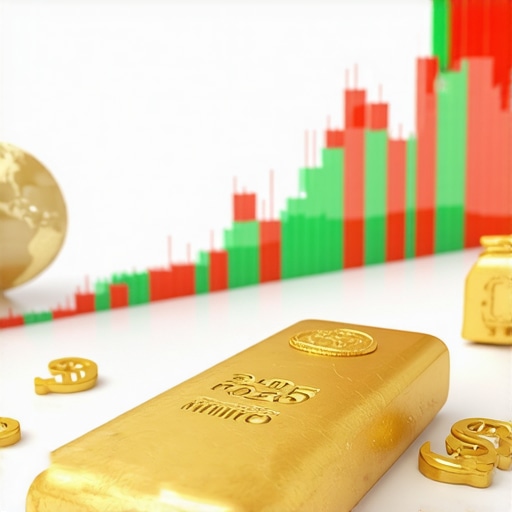Decoding Gold Demand: The Multifaceted Drivers of Price Dynamics
The intricate dynamics of gold demand underpin the metal’s price fluctuations and investment appeal. Beyond simplistic supply-demand narratives, understanding the nuanced factors that drive gold prices requires a deep dive into economic indicators, geopolitical tensions, and monetary policies shaping global markets in 2025. Investors and analysts alike must navigate these layers to anticipate market movements effectively.
Monetary Policy and Central Bank Gold Buying: Strategic Influences on Market Liquidity
Central banks remain pivotal in influencing gold demand, not merely as holders of reserves but as active market participants. Their strategic gold purchases, often correlated with currency diversification and economic uncertainty hedging, significantly affect global supply-demand balance. For instance, the recent patterns of increased central bank gold acquisitions in emerging economies have contributed to tighter physical supply, exerting upward pressure on prices. This interplay is critical for investors analyzing macroeconomic trends and portfolio risk management.
How Do Inflation Expectations and Real Interest Rates Shape Gold Demand in 2025?
Inflation expectations and real interest rates form a complex relationship with gold demand. As a traditional inflation hedge, gold often attracts investment when inflation outpaces real yields on bonds and savings. However, when real interest rates rise, the opportunity cost of holding non-yielding gold increases, potentially suppressing demand. The 2025 environment, characterized by volatile inflation metrics and fluctuating central bank policies, creates a nuanced scenario where gold’s appeal oscillates between safe haven and speculative asset depending on investor sentiment and economic forecasts.
Technological Advancements and Industrial Demand: Emerging Trends Impacting Gold Consumption
While investment and central bank demand dominate headlines, industrial applications—particularly in electronics and medical devices—contribute steadily to gold consumption. Technological innovations drive this demand, influencing long-term price trends subtly yet persistently. Advanced manufacturing techniques and increased utilization in green technologies suggest a gradual but meaningful expansion of industrial gold demand, adding complexity to overall market dynamics.
Investor Behavior and Market Sentiment: The Psychological Underpinnings of Gold Price Movements
Investor psychology, shaped by market sentiment, geopolitical crises, and financial market volatility, often precipitates rapid demand shifts. Understanding these behavioral patterns through analytical frameworks such as sentiment indices and trading volume anomalies enables more precise forecasting. Notably, gold’s role as a safe haven asset intensifies during periods of uncertainty, reinforcing its price resilience despite fundamental supply-demand considerations.
For those seeking to deepen their understanding of gold investment strategies amid these evolving demand trends, exploring comprehensive analyses such as Analyzing Gold Demand Trends for Smarter Investment Decisions in 2025 is highly recommended.
To further enhance your expertise and discuss the implications of these factors on your investment portfolio, consider contributing your insights or engaging with expert forums dedicated to precious metals market analysis.
Authoritative insights on the impact of monetary policy and inflation on gold prices can be found in the report by the World Gold Council: Gold and Inflation Analysis.
Geopolitical Risk and Its Multifaceted Impact on Gold Prices
Gold’s reputation as a refuge during geopolitical instability remains robust, but the intricacies of how different types of risks influence demand and pricing require careful dissection. Conflicts, trade tensions, and diplomatic uncertainties can trigger sudden spikes in gold prices as investors seek safe haven assets. However, the duration and intensity of these price movements depend on the geopolitical event’s scope and the responses by global powers. For example, prolonged trade disputes might push investors toward gold ETFs and bullion, while short-term crises can stimulate speculative trading in futures markets. Understanding these nuances enhances the timing and selection of gold investment vehicles.
Demystifying Supply Chain Constraints: Mining Output and Recycling Trends
Supply-side factors increasingly shape gold market dynamics alongside demand drivers. Fluctuations in mining production, often affected by geopolitical labor issues, environmental regulations, and technological disruptions, can create supply bottlenecks that influence price volatility. Concurrently, recycling gold from electronic waste and jewelry contributes materially to supply, particularly during periods of elevated prices. Investors should monitor mining industry reports and recycling rates to anticipate shifts in physical availability that could impact market valuation.
What Are the Emerging Analytical Tools for Forecasting Gold Price Movements Amid Complex Market Interactions?
Advanced analytical frameworks integrating machine learning algorithms, sentiment analysis, and macroeconomic modelling are revolutionizing gold price forecasting. These tools synthesize multidimensional data—ranging from central bank activities and inflation expectations to social media sentiment and geopolitical event tracking—to generate probabilistic price scenarios. For instance, combining in-depth gold market analysis with sentiment indices offers a more granular understanding of price catalysts. Adopting such sophisticated methodologies allows investors and portfolio managers to navigate the inherently volatile gold market with enhanced precision and strategic foresight.
Integrating Gold into Diversified Portfolios: Balancing Risk and Return
Incorporating gold effectively requires a nuanced approach that weighs its unique characteristics against other asset classes. Gold’s low correlation with equities and bonds makes it a powerful diversification tool, especially during economic downturns or inflationary cycles. However, portfolio allocation must consider liquidity preferences, investment horizon, and tax implications. Utilizing structured products like gold ETFs or physical holdings in IRAs can optimize portfolio resilience. For practical guidance, readers may explore strategies such as Gold vs Stocks: How to Build a Balanced Investment Portfolio.
For further discussion and expert insights on sophisticated gold investment methods and market interpretations, please share your thoughts or questions in the comments below. Engaging with a community of knowledgeable investors can deepen understanding and refine strategy implementation.
For authoritative perspectives on gold market analytics, see the comprehensive research by the World Gold Council: Gold Market Insights.
Harnessing Artificial Intelligence for Predictive Gold Market Analytics
Artificial intelligence (AI) and machine learning have ushered in a paradigm shift in how investors and analysts approach gold market forecasting. By processing vast datasets encompassing central bank transactions, inflation metrics, social media sentiment, and geopolitical developments, AI models uncover latent patterns imperceptible to traditional analysis. These sophisticated algorithms employ natural language processing to gauge market mood from news and tweets, while reinforcement learning adapts dynamically to evolving market conditions, thereby enhancing predictive accuracy.
However, the integration of AI into gold price forecasting is not without challenges. Model overfitting, data biases, and the black-box nature of some algorithms necessitate careful validation and domain expertise to interpret outputs meaningfully. Hybrid models combining econometric fundamentals with AI-driven insights are emerging as best practices, offering a balanced approach that leverages both quantitative data and qualitative intelligence.
How Can Behavioral Finance Enrich AI Models in Forecasting Gold Price Movements?
Behavioral finance introduces critical psychological variables such as investor sentiment, herd behavior, and risk aversion, which profoundly influence gold demand but remain elusive to purely quantitative models. Incorporating sentiment indices derived from investor surveys and trading volumes into AI frameworks enables the capture of market irrationalities and speculative dynamics that drive short-term price volatility.
For example, during geopolitical crises, fear-induced buying patterns often precipitate abrupt gold price surges that traditional models might underestimate. By embedding behavioral signals, AI models can anticipate such anomalies, providing investors with strategic advantage. This interdisciplinary fusion underscores the necessity of combining advanced technology with human behavioral insights for nuanced gold market analysis.
Geopolitical Event Modeling: Quantifying Risk Impact on Gold Valuation
Quantitative modeling of geopolitical risks involves assigning probabilistic impacts to various event typologies—ranging from armed conflicts and trade embargoes to diplomatic negotiations—and their likely duration and intensity. Scenario analysis techniques simulate potential market responses, enabling investors to stress-test portfolios against adverse geopolitical developments.
Recent advances include the use of event study methodologies that analyze historical gold price reactions to specific geopolitical triggers, thereby calibrating predictive models more accurately. Additionally, integrating real-time geopolitical risk indices, such as the Global Peace Index or the Geopolitical Risk Index (GPR), facilitates dynamic adjustment of gold price forecasts in response to unfolding events.
These models are invaluable for timing entry and exit points in gold investments, especially for sophisticated market participants who seek to capitalize on transient risk-driven price dislocations.
Supply Chain Analytics: Anticipating Gold Market Volatility through Mining and Recycling Trends
Supply-side analytics have evolved from static production reporting to real-time monitoring of mining outputs and recycling flows. Technologies such as satellite imagery and IoT sensors now allow near-instantaneous tracking of mine activity, labor disputes, and environmental compliance, providing early warnings of potential supply disruptions.
Parallelly, advancements in recycling analytics quantify the elasticity of secondary gold supply, particularly from electronic waste streams, which respond to price incentives with variable lags. Understanding these dynamics is crucial as recycling can offset or amplify mining shortfalls, thereby influencing gold’s physical availability and price stability.
Investors should integrate these granular supply indicators with demand-side factors to develop comprehensive risk models that anticipate periods of heightened volatility or sustained price trends.
For a deeper dive into cutting-edge gold market analytics that combine AI, geopolitical risk modeling, and supply chain intelligence, visit In-Depth Gold Market Analysis.
Engage with our expert community and contribute your perspectives to refine these models further and enhance collective market understanding.
Behavioral Finance Meets Artificial Intelligence: Enhancing Predictive Precision in Gold Markets
Integrating behavioral finance insights into AI-driven models represents a frontier in gold price forecasting. Traditional econometric methods often fall short in capturing the nuances of investor psychology and sentiment-driven volatility. By embedding behavioral variables such as overconfidence, loss aversion, and herding effects into machine learning frameworks, analysts can better anticipate abrupt market shifts induced by collective investor behavior.
What Are the Leading Behavioral Indicators That Improve AI Forecasting Models for Gold Prices?
Key behavioral indicators enhancing AI models include sentiment indices derived from real-time social media analytics, volume-weighted average price anomalies, and investor sentiment surveys. For instance, spikes in fear and uncertainty indexes often precede significant gold price rallies. Incorporating these metrics enables AI algorithms to detect precursors to market panic or exuberance, thereby refining predictive accuracy beyond fundamental economic signals.
Research published by the Financial Times highlights the efficacy of combining behavioral finance with AI, noting that hybrid models outperform traditional approaches during periods of heightened market stress (Financial Times on Behavioral AI in Gold Markets).
Dynamic Geopolitical Risk Quantification: Leveraging Real-Time Indices and Scenario Simulations
Advancements in geopolitical risk modeling now utilize dynamic indices like the Geopolitical Risk Index (GPR) and machine-readable news feeds to quantify event impacts on gold valuations in near real-time. Scenario-based simulations integrate these indices with macroeconomic variables, enabling investors to stress-test portfolio resilience against multifaceted geopolitical shocks.
This approach facilitates granular differentiation between transient trade disputes and protracted armed conflicts, informing tactical asset allocation and hedging strategies tailored to event severity and duration.
Supply Chain Intelligence: Harnessing Satellite and IoT Data to Forecast Physical Gold Availability
Real-time supply chain analytics have evolved with the integration of satellite surveillance and IoT-enabled mining equipment monitoring. These technologies provide granular insights into mine operational status, environmental compliance, and labor disruptions, which are critical for anticipating supply constraints that can precipitate price volatility.
Moreover, sophisticated recycling flow models, informed by price elasticity and consumer behavior analytics, offer predictive capabilities on secondary gold supply contributions, further refining market forecasts.

Strategic Portfolio Integration: Optimizing Gold Allocation Through Advanced Quantitative Models
Incorporating gold into diversified portfolios demands advanced quantitative approaches that balance risk-adjusted returns with liquidity and tax considerations. Multi-factor models integrating AI-derived forecasts, geopolitical risk assessments, and supply-demand analytics enable portfolio managers to calibrate gold allocations dynamically, optimizing for macroeconomic cycles and market sentiment shifts.
Such strategies leverage structured products, physical holdings, and derivatives to tailor exposure, enhancing portfolio resilience in an increasingly complex investment landscape.
We invite readers to engage with these advanced insights and share their experiences or queries within our expert forums, fostering a collaborative environment for continuous learning and strategic refinement.
Expert Insights & Advanced Considerations
The Confluence of Behavioral Finance and AI Enhances Forecasting Precision
Integrating behavioral finance indicators such as investor sentiment, herd mentality, and risk aversion into AI-driven predictive models significantly refines the ability to anticipate gold price fluctuations. This interdisciplinary approach captures market irrationalities often missed by traditional econometric models, providing investors with nuanced insights into volatility triggers and timing opportunities.
Geopolitical Risk Modeling as a Tactical Investment Tool
Dynamic geopolitical risk quantification using indices like the Geopolitical Risk Index (GPR) and real-time event simulations allows investors to assess the probable impacts of global tensions on gold valuations. These models facilitate more tactical asset allocations and hedging strategies, tailoring exposure to the severity and duration of geopolitical events.
Supply Chain Analytics: A Critical Element in Price Volatility Forecasting
Advancements in supply chain intelligence—leveraging satellite data, IoT monitoring, and recycling flow analytics—offer unprecedented visibility into mining output and secondary gold availability. Recognizing supply constraints or surpluses early enables more accurate anticipation of gold price volatility and longer-term trends.
Portfolio Optimization Through Multifactor Quantitative Models
Employing multifactor models that integrate AI forecasts, geopolitical risk assessments, and supply-demand analytics empowers portfolio managers to dynamically adjust gold allocations. This quantitative rigor enhances risk-adjusted returns and liquidity management, especially during macroeconomic cycles characterized by uncertainty and inflationary pressures.
Technological Innovation Driving Industrial Gold Demand Growth
The expanding role of gold in emerging technologies—from electronics to green energy applications—incrementally increases industrial demand. While subtle, this trend contributes to overall market complexity and should be integrated into long-term demand forecasts for a holistic investment strategy.
Curated Expert Resources
World Gold Council – Gold Market Insights: Offers comprehensive research on global gold market trends, inflation impacts, and central bank activities, essential for understanding macroeconomic influences on gold prices (Gold Market Insights).
Buying Gold Now – In-Depth Gold Market Analysis: A detailed analysis combining AI analytics, geopolitical risk modeling, and supply chain intelligence that equips investors with a granular understanding of price drivers (In-Depth Gold Market Analysis).
Financial Times – Behavioral Finance and AI in Gold Forecasting: Explores the integration of psychological market factors into AI models, highlighting improved predictive performance during market stress (Financial Times on Behavioral AI in Gold Markets).
Global Peace Index and Geopolitical Risk Index (GPR): Real-time indices providing quantifiable measures of geopolitical risk, invaluable for scenario analysis and investment decision-making.
Buying Gold Now – Strategic Portfolio Integration: Guidance on multifactor quantitative approaches to optimize gold allocation within diversified portfolios, balancing liquidity, tax considerations, and market cycles (Gold vs Stocks: How to Build a Balanced Investment Portfolio).
Final Expert Perspective
The complexity of gold demand and price dynamics in 2025 requires a sophisticated, multidisciplinary approach that blends behavioral finance, artificial intelligence, geopolitical risk modeling, and supply chain analytics. Investors who leverage these advanced insights are better positioned to anticipate market movements, strategically optimize their portfolios, and capitalize on emerging industrial trends. Gold remains a cornerstone asset for diversification and wealth preservation, but mastery of its multifaceted drivers is essential in today’s volatile environment. Engage with the wealth of expert analyses and strategic resources available to refine your approach and deepen your investment acumen in gold markets. For practical strategies on secure acquisition and portfolio integration, explore our guides on how to buy gold bullion safely and building a balanced investment portfolio with gold.











This comprehensive overview really highlights how multifaceted gold demand is in 2025. I’ve been particularly interested in how central bank activities are shaping supply and demand, especially with the increased acquisitions in emerging economies. It makes me wonder, though—how do these central bank strategies interact with investor behavior during market volatility? From my experience, when geopolitical tensions rise, many retail investors tend to rush into gold, but large institutional players may approach differently, especially with algorithms and AI tools coming into play. Have any of you experimented with combining traditional analysis with AI-driven data to anticipate demand shifts more accurately? I believe understanding the behavioral side, especially in the context of rapid technological advancements, could really give investors an edge in timing their entries or exits. It’s clear that the space is evolving rapidly, and integrating these insights could help in building more resilient portfolios during unpredictable times.